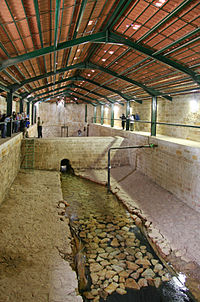
Jericho is a city in the West Bank; it is the administrative seat of the Jericho Governorate of the State of Palestine. Jericho is located in the Jordan Valley, with the Jordan River to the east and Jerusalem to the west. In 2017, it had a population of 20,907.

Byblos, also known as Jebeil, Jbeil or Jubayl, is an ancient city in the Keserwan-Jbeil Governorate of Lebanon. The area is believed to have been first settled between 8800 and 7000 BC and continuously inhabited since 5000 BC. During its history, Byblos was part of numerous cultures including Egyptian, Phoenician, Assyrian, Persian, Hellenistic, Roman, Genoese, Mamluk and Ottoman. Urbanisation is thought to have begun during the third millennium BC and it developed into a city making it one of the oldest cities in the world. It is a UNESCO World Heritage Site.
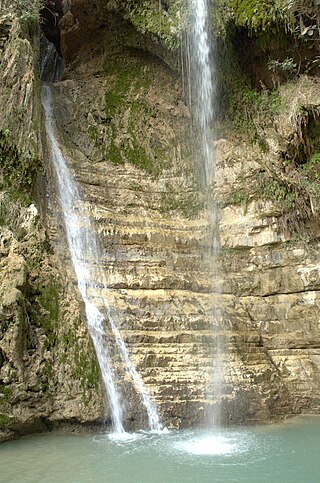
Ein Gedi, also spelled En Gedi, meaning "spring of the kid", is an oasis, an archeological site and a nature reserve in Israel, located west of the Dead Sea, near Masada and the Qumran Caves. Ein Gedi, a kibbutz, was established nearby in 1954.
Bryant G. Wood is an American biblical archaeologist and Young Earth creationist. Wood is known for arguing that the destruction of Jericho could be accorded with the biblical literalist chronology of c. 1400 BC. This date is some 150 years later than the accepted date of c. 1550 BC, first determined by Kathleen Kenyon and subsequently confirmed with radiocarbon dating.

Ein Karem is a historic mountain village southwest of Jerusalem, presently a neighborhood in the outskirts of the modern city, within the Jerusalem District. It is the site of the Hadassah Medical Center.

Mount of Temptation, in Palestinian Arabic Jebel Quruntul, is a mountain over the city of Jericho in the West Bank, in the State of Palestine; ancient Christian tradition identifies it as the location of the temptation of Jesus described in the New Testament Gospels of Matthew, Mark, and Luke, in which it is said that, from "a high place", the Devil offered Jesus rule over all the kingdoms of the world.

A proto-city is a large, dense Neolithic settlement that is largely distinguished from a city by its lack of planning and centralized rule. While the precise classification of many sites considered proto-cities is ambiguous and subject to considerable debate, common examples include Jericho, Çatalhöyük and the mega-sites of the Cucuteni-Trypillia culture. Sites of the Ubaid period in Mesopotamia have also been classed as proto-cities. These sites pre-date the Mesopotamian city-states of the Uruk period that mark the development of the first indisputable urban settlements, with the emergence of cities such as Uruk at the end of the Fourth Millennium, B.C.

The Jericho Governorate is one of 16 Governorates of Palestine. Its capital is Jericho. The governorate is located along the eastern areas of the West Bank, along the northern Dead Sea and southern Jordan River valley bordering Jordan. It spans west to the mountains east of Ramallah and the eastern slopes of Jerusalem, including the northern reaches of the Judaean Desert. The population of the Jericho Governorate is estimated to be 50,002, including 13,334 Palestinian refugees in the governorate's camps.

Ras al-Ayn, also spelled Ras al-Ain, is a city in al-Hasakah Governorate in northeastern Syria, on the Syria–Turkey border.

Wadi Qelt, in Hebrew Nahal Prat, formerly Naḥal Faran, is a valley, riverine gulch or stream in the West Bank, originating near Jerusalem and running into the Jordan River near Jericho, shortly before it flows into the Dead Sea.
ʿEin es-Sulṭān camp, or ʿEin Sultan camp, is a refugee camp in the Jericho Governorate of the State of Palestine, in the Jordan Valley, in the eastern West Bank. The village is located adjacent to the Ein es-Sultan or Elisha Spring, for which it is named, and the archaeological site of Tell es-Sultan, 1 kilometer north-west of the city of Jericho.

Many place names in Palestine were Arabized forms of ancient Hebrew and Canaanite place-names used in biblical times or later Aramaic formations. Most of these names have been handed down for thousands of years though their meaning was understood by only a few. The cultural interchange fostered by the various successive empires to have ruled the region is apparent in its place names. Any particular place can be known by the different names used in the past, with each of these corresponding to a historical period. For example, the city of Beit Shean, today in Israel, was known during the Israelite period as Beth-shean, under Hellenistic rule and Roman rule as Scythopolis, and under Arab and Islamic rule as Beisan.
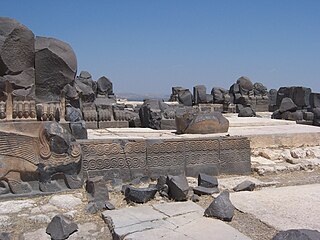
The Ain Dara temple is a destroyed Iron Age Syro-Hittite temple noted for its similarities to Solomon's Temple, also known as the "First Temple in Jerusalem", as described in the Hebrew Bible. It is located near the village of Ain Dara, in Afrin District, Syria.

Ein Feshkha or Einot Tzukim is a 2,500 ha nature reserve and archaeological site on the north-western shore of the Dead Sea, about 3 km (1.9 mi) south of Qumran in the West Bank. It is located just north of the headland Râs Feshkhah, the "headland of Feshkhah". Within the reserve is a group of springs of brackish water. The nature reserve consists of an open section with pools of mineral water for bathing surrounded by high foliage and a section that is closed to visitors to protect the native flora and fauna.
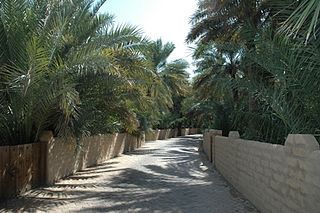
Al-Ain Oasis is the largest oasis in the city of Al Ain, within the Eastern Region of the Emirate of Abu Dhabi, the United Arab Emirates.
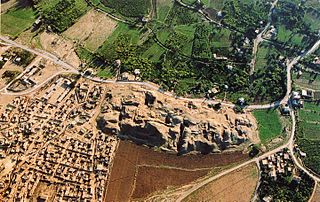
Tell es-Sultan, also known as Tel Jericho or Ancient Jericho, is an archaeological site and a UNESCO World Heritage Site in the State of Palestine, in the city of Jericho, consisting of the remains of the oldest fortified city in the world.
Lorenzo Nigro is an Italian archaeologist, novelist and watercolorist. He is Full Professor of Near Eastern Archaeology in the Faculty of Letters and Philosophy at Sapienza University of Rome. He directs three main archaeological expeditions: at Jericho in Palestine, with the Ministry of Tourism and Antiquities, at the Early Bronze Age fortified city, previously unknown, of Khirbet al-Batrawy in the Hashemite Kingdom of Jordan, and at Motya, a Phoenician city in Western Sicily, while also acting as co-director of the Institut national du patrimoine-Sapienza University of Rome Expedition to Carthage in Tunisia. Since 2015 he started the archaeological exploration and protection activities, again in cooperation with the Palestinian Ministry of Tourism and Antiquities, in the Bronze and Iron Age necropolises of the Bethlehem urban area and at the site of Tell esh-Sheikh Abu Zarad, ancient Tappuah. In all these excavations he has been the protagonist of several important discoveries, from the reconstruction of the Bronze Age city at Jericho, to the Temple of the Kothon at Motya, to the entire unknown city of Batrawy with its magnificent fortifications and the Palace of the Copper Axes, and the Broad Room temple. At Motya it has uncovered at least four temples and detailed a prehistoric stratigraphy at the foot of the acropolis showing that the island in Sicily was occupied and known to Mediterranean sailormen since the beginning of the 2nd millennium BC.

Ma'ayan Harod or Ain Jalut is an all-year spring in the Jezreel Valley on the northwest corner of Mount Gilboa that was the location of the 13th-century Battle of Ain Jalut. This was a major turning point in world history that saw the Mamluks inflict the first of two defeats on the Mongols that ultimately halted their invasion of the Levant and Egypt.

The ʿAin Ghazal statues are a number of large-scale lime plaster and reed statues discovered at the archeological site of ʿAin Ghazal in Amman, Jordan, dating back to approximately 9000 years ago, from the Pre-Pottery Neolithic C period. A total of 15 statues and 15 busts were discovered in 1983 and 1985 in two underground caches, created about 200 years apart.

